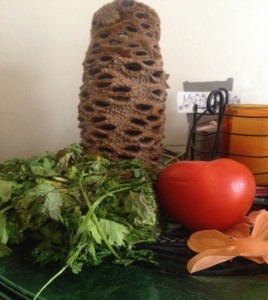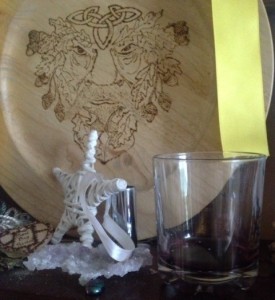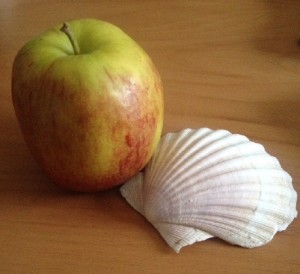Feeding the Ancestors
Samhain is almost upon us. We’ve passed the equinox, the point of no return; the balance of light and dark; the perfect union of night and day. The nights are visibly longer now, and we know we are heading into the winter months. In years gone by we would be storing our food away, slaughtering beasts that could not survive the harsh winter and carefully caring for those that would.
We may now live in a world of supermarkets and central heating, but for those of us who feel the turn of the wheel in the changing of the season, Samhain (in part) is still about making sure everyone is fed; that’s everyone, including those who are no longer with us.
Most of you will know that Samhain is generally regarded, in most paths that fall under the Pagan heading, as a festival of the dead. This often sounds bleak and morbid, but in my experience it is about celebrating the lives of those who came before us, the joy they brought and the gifts they have left behind. It’s also about looking further back into the past and honouring our distant ancestors, perhaps those that aren’t even our direct bloodline but influenced the path you are now walking, or the decisions you have made to be where you are today. Mentors, friends and treasured animal companions can all be thanked and called into our homes for a short period before they return behind the veil, and become memories or history once more.
This idea of sharing our home or sacred space with those important to us in some way is almost universally appealing. So how do we make them welcome? Well, how do you make any guest feel welcome and relaxed? Simple: you offer them food and drink. Sometimes we forget that the ‘offerings’ we leave upon our altars, doorsteps, crossroads or shrines are more than simply fulfilling ritual obligation. We are literally offering something good to someone (or something) we want to please in some way.
How to decide what sort of sustenance to offer? Again, return to the theory of adding offerings to a sacred space. You may use bread and mead. Why? What significance does this have? Does your deity/spirit have a history of being offered these? Or is there a myth which involves said delights? Research is key when deciding what offerings to use, and often we can use the experience of those we are learning from which is fantastic. For reaching out to or honouring your ancestors or forebears, the same applies. If this was a person (or pet) you know, you may already have a choice snack in mind. I leave a cup of tea out for my nana, in a china cup if one is available. Have a think about what that person or animal loved. I’m not suggesting you go all out and make a four course meal, but perhaps a favourite item from within a favourite meal, or a small glass of a beloved tipple. Or perhaps a taste that you once shared, that is representative of the bond between you and this person.
For those more distant ancestors, more traditional research may be required. If you are hoping to welcome members from way back in your family tree, but still within the last few generations, you may have the luxury of asking grandparents or great-grandparents. Sadly all my grandparents have moved beyond the veil now, and it is them I leave the offerings for at Samhain. But yours may be a wealth of information about older or more distant relatives.
Honouring your spiritual ancestors is a different matter. For example, if you are on a Heathen path you may wish to honour the ancient Norse. If you are a follower of Lugh you may wish to honour the Celts. What foods should you choose then? There are, of course, no hard and fast rules but the clues are generally in the literature of the time, or in the case of the Celts, in what little literature we have from the Middle Ages when most of their tales were actually documented. Read the legends and absorb details of feasts, meals, celebrations; what did these people enjoy? What foods are mentioned again and again? Are they constantly boozing, or do they drink milk and water?
This is a very brief list that gives different foods for different peoples, and their associations. It is nowhere near exhaustive; indeed, it merely dapples the surface of an ever deepening pond. I hope it inspires you to find the perfect food to offer your ancestors this Samhain, and perhaps to find a deeper connection with those who came before you.
Celts
Apples- Longevity, health.
Honey- Spiritual connection.
Mead- Other realms, the place beyond death.
Salmon- Wisdom, intellect.
Lamb and pork- slow cooked is likely the way the Celts would have eaten it, as archaeologists across the UK have discovered what seem to be pits used for cooking meat with hot stones, which date from the Bronze Age.
Hazelnuts- The boundary of this world and the next, wisdom, magic.
Greeks
Honey- poetry, words.
Garlic- Protection.
Almonds- Hope, undying love.
Olive oil- Journey of dead souls.
Vine leaves- Freedom, revelry.
Fish- Traditional fare.
Egyptians
Honey- royalty.
Beer (something thick, ideally home brewed) – nourishment, sleep, new beginnings.
Bread, ideally barley- traditional fare.
Spring onions and Garlic- health and wellbeing.
Dates- traditional fare.
Figs- Mother and maternal instinct.
Dried Fish- companionship, comradery.
Garlic- courage.
Norse
Mead- spirit, poetry, ecstasy; inspiration, knowledge.
Ale- Earth, the power of earth.
Eggs- a traditional part of ancient Scandinavian diet and mentioned in the Egils saga Skallagrímssonar.
Fish, particularly salmon- as above.
Milk- Cattle farming was particularly important in the ‘Viking Age’, so beef is good as well.
Pork- represents Sæhrímnir, the beast eaten over and over in Valhalla. The beast may be a boar, but there is some debate over this.
Saxon
Bread- the union of the elements.
Barley beer- cleanliness, purity.
Wine- wealth, abundance.
Pork or ham- the most abundant meat for Anglo-Saxons.
Carrots or Parsnips- standard fare.
Onions- warding off evil.
Apples, cherries or plums- the gifts of nature.
Mexican
Marigolds are used to attract the spirits of the dead to the offerings.
Sugar skulls- remembering each soul; making the most of what you have.
Fruit- traditional offering.
Nuts- traditional offering.
Pan de Muerto- may be decorated with bones to represent the deceased, or a tear drop to represent the tears of the Goddess Chimalma.
Candied Pumpkin- seasonal.
Tequila- celebration!
Atole- warmth and nourishment.
Remember; don’t attempt to contact your ancestors without experienced help. Speaking with or even simply sharing a space with spirits can be daunting for the inexperienced. If, indeed, you have that experience, or good company, then may you feast with all those you love, past and present. I wish you a blessed and delicious Samhain, with warmth for your hearts and hearths as we draw ever closer to winter.
***
About the Author:
Mabh Savage is a Pagan author, poet and musician, as well as a freelance journalist.
She is the author of A Modern Celt: Seeking the Ancestors and Pagan Portals: Celtic Witchcraft.
Follow Mabh on Twitter, Facebook and her blog.


